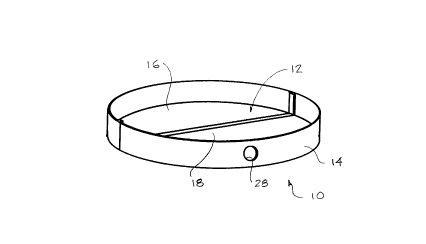Note: Descriptions are shown in the official language in which they were submitted.
2 1 87824
DRAIN PAN FOR HOT WATER HEATERS AND WATER SO -lrN~S
The present invention relates to drain pans and more
particularly to drain pans for water tanks, for example, hot water tanks.
Water tanks, for example hot water tanks and water softener
tanks, are often located in finished areas of a building. In domestic uses,
5 these tanks are often located in finished basements. The tanks may corrode
over time and ultimately burst, discharging the enclosed water. This may
cause damage to carpets, finished walls and furnishings. To deal with this,
it has been known to place a sheet metal drain pan under a tank when it is
installed. The pan is drained by a hose to a floor drain. The value of these
10 metal pans is not particularly great since the metal pan may corrode and be
incapable of performing its intended function when needed.
This problem can be solved by using a plastic material for the
drain pan. Non-corroding plastic pans, like their metal predecessors, can
only be installed with new tanks, since the tank must physically be lifted
15 into the pan. This is prevented by both the weight of an in service water
tank and the plumbing connected to it.
The present invention is intended to ameliorate certain problems
with the prior art.
According to one aspect of the invention there is provided a
20 drain pan for water tanks comprising a water impervious base panel of
corrosion resistant material, a water impervious peripheral skirt of corrosion
resistant material projecting upwardly from the base panel and a drain port
in the skirt, wherein the pan comprises two components, each including
respective portions of the base panel and the skirt and coupling means for
25 forming a water impervious coupling between the two components.
By making the pan in two parts, it is possible to slip one part
under one or two feet of an installed tank by tipping the tank slightly, and
then to slip the other part under the tank in the same way. The two parts
2 1 87824
are then coupled to provide the complete, water impervious pan under the
tank. This installation is easily done, even as a retrofit to existing tanks.
The pan may be circular, with a cylindrical skirt. The two
components may then join along a diametrical seam. The coupling means
5 may be a channel on one component edge and a bead along the other.
Where desired, a gasket may be placed in the base of the channel to ensure
the water impervious nature of the pan.
In the accompanying drawings, which illustrate an exemplary
embodiment of the present invention:
Figure 1 is an isometric view of a drain pan according to the
present invention.
Figure 2 is a cross section along the line 2-2 of Figure 1.
Figures 3A, 3B and 3C schematically illustrate the installation of
the drain pan under a water tank.
Referring to the accompanying drawings, there is illustrated a
drain pan 10 with a circular base panel 12 and an annular, cylindrical skirt
14 extending peripherally above the base panel. The base panel is divided
into two halves 16 and 18 along a diametrical seam. The seam is composed
of a channel 20 along the edge of pan half 16 and a mating bead 22 that
snaps into the re-entrant channel behind two lips 24 at the free edges of the
channel. The lips thus hold the bead firmly in place. A rod 26 of
compressible foam material is seated in the base of the channel as a gasket
to be engaged by the bead to ensure a water impervious seal between the
two components of the pan.
A threaded port 28 is formed in the skirt 14 and is sized for
coupling to a 3/4 inch (2 cm) hose.
The installation of the pan under a water tank is illustrated in
Figures 3A, 3B and 3C. The water tank 30 is tipped slightly to one side.
2 1 87824
Even with a plumbed in, full tank, this is usually possible to the extent that it
will lift a foot 32 of the tank off the floor on which it is resting sufficiently
that the base panel part of one component of the pan can be slid under the
foot to approximately the centre of the water tank. The tank can then be
5 tipped up to the other side to slide the other component of the pan under
the feet 32 of the tank. The two components of the pan are then snapped
together along the seam. A hose screwed into the port 28 leads to a floor
drain to drain off any liquid accumulating in the pan as the result of a
ruptured tank.
While one particular embodiment of the present invention has
been described in the foregoing, it is to be understood that other
embodiments are possible with the scope of the invention and are intended
to included herein. The invention is to be construed as limited solely by the
scope of the appended claims.
